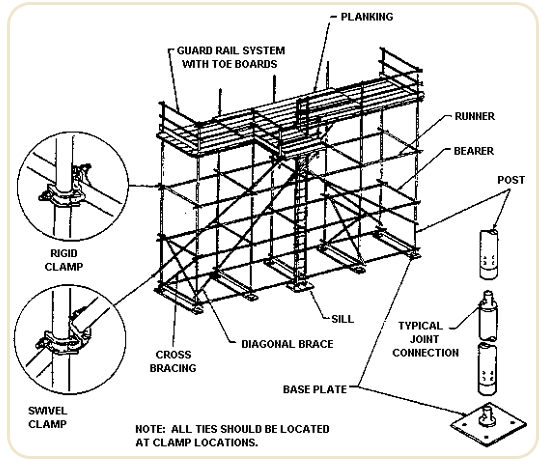Professional Scaffolder Surrey: Your Trusted Partner for Safe Installations
Professional Scaffolder Surrey: Your Trusted Partner for Safe Installations
Blog Article
A Comprehensive Guide to the Important Attributes of Scaffolding in Modern Construction
The landscape of modern building increasingly relies upon effective scaffolding systems that prioritize safety and security, performance, and advancement. As tasks grow in intricacy, recognizing the crucial functions of scaffolding comes to be important for making certain worker safety and optimizing project timelines. This overview explores various sorts of scaffolding, highlights crucial security attributes, and examines material developments that contribute to efficiency and sustainability. Nonetheless, the ramifications of these components prolong far beyond mere building practices, prompting a more detailed consider just how they influence general job success and employee well-being.
Types of Scaffolding
Although scaffolding systems can differ extensively in design and application, they usually fall under a number of unique categories that satisfy various building requirements - Scaffolding. One of the most usual kinds consist of sustained scaffolding, suspended scaffolding, and rolling scaffolding
Supported scaffolding is composed of systems supported by a framework of poles, which give a elevated and stable functioning surface. This kind is commonly utilized for jobs that need significant altitude, such as bricklaying or exterior painting.
Suspended scaffolding, alternatively, is utilized for tasks needing accessibility to high altitudes, such as cleaning or repairing building exteriors. This system hangs from a roof or another framework, permitting workers to reduced or elevate the system as required.
Moving scaffolding attributes wheels that enable easy wheelchair across a work website. It is particularly beneficial for tasks that require frequent relocation, such as interior operate in large rooms.
Each sort of scaffolding is created with specific applications in mind, making certain that building and construction projects can be lugged out successfully and properly. Comprehending these categories is essential for picking the ideal scaffolding system to meet both project needs and website problems.
Trick Security Attributes
Safety is paramount in scaffolding systems, as the potential dangers connected with operating at heights can bring about severe accidents otherwise effectively taken care of. Key safety attributes are vital to ensure the wellness of workers and the honesty of the building and construction website.
Firstly, guardrails are critical. These barriers give a physical secure versus drops, substantially minimizing the danger of significant injuries. Additionally, toe boards are often utilized to avoid tools and materials from diminishing the scaffold, protecting workers below.
An additional crucial part is making use of non-slip surface areas on systems. This function boosts hold, especially in unfavorable climate conditions, consequently lessening the likelihood of slips and drops. Access ladders must be safely positioned to assist in secure entry and leave from the scaffold.
Regular evaluations and upkeep of scaffolding systems are likewise crucial. These evaluations guarantee that all parts remain in excellent problem and operating appropriately, dealing with any type of wear or damages promptly.
Finally, correct training for all workers associated with scaffolding procedures is crucial to make sure that they understand security methods and can recognize possible dangers. Scaffolding. Jointly, these attributes produce a more secure working environment and significantly mitigate risks linked with scaffolding
Product Innovations
Innovations in material science have actually dramatically affected the scaffolding sector, boosting both safety and security and efficiency in modern building and construction. The intro of high-strength steel and aluminum alloys has actually revolutionized typical scaffolding systems.
In addition, ingenious composite materials, such as fiberglass-reinforced plastics, have become practical alternatives. These products are immune to rust and ecological deterioration, thus extending the life expectancy of scaffolding systems, particularly in harsh climate condition. Making use of such materials adds to decrease upkeep prices and ensures constant performance with time.


Design Factors To Consider
Considering the complexities of contemporary construction tasks, effective scaffolding style is paramount to ensuring both capability and safety and security. Style considerations should incorporate different elements, consisting of tons capability, height, and the particular needs of the building website. Each project provides special difficulties, demanding an adaptable strategy to scaffolding systems that can adjust to differing problems.
Structural integrity is vital; consequently, designers should compute the tons that the scaffolding will support, including employees, products, and tools. The choice of materials plays an essential function in ensuring the scaffolding can endure these tons while remaining sturdy and light-weight. Furthermore, the design should enable simple accessibility and egress, helping with the smooth movement of employees and materials.
Safety attributes, such as guardrails and non-slip surface areas, need to be included to decrease dangers of accidents. Additionally, the design should consider the surrounding environment, including prospective hazards and nearby frameworks. By attending scaffolding zone of proximal development to these layout factors to consider, construction firms can boost the effectiveness of scaffolding systems and promote a safer working setting, ultimately adding to the total success of the task.
Upkeep and Examinations
The performance of scaffolding systems prolongs past first layout and execution; continuous upkeep and normal inspections are vital to ensuring their proceeded efficiency and safety and security throughout the duration of a job. Routine evaluations ought to be conducted by certified employees to determine any indicators of wear, damages, or instability that can endanger the honesty of the scaffolding.
Upkeep procedures ought to include routine checks of structural components, such as installations, frames, and planks, ensuring that all components stay secure and free from rust or other deterioration. Additionally, the functionality of safety and security functions, such as guardrails and toe boards, must be analyzed to make sure compliance with safety and security guidelines.
Documentation of all examinations and maintenance activities is vital for liability and regulative conformity. A systematic strategy to record-keeping not only help in tracking the condition of the scaffolding yet likewise gives necessary proof in the event of an event.
Eventually, developing an extensive maintenance and inspection routine will significantly decrease the threat of accidents and improve the overall security of the building and construction site. By focusing on these techniques, building supervisors can protect employees and promote the project's stability.

Verdict
Finally, the vital functions of scaffolding in contemporary building encompass a series of crucial elements, including varied kinds, crucial security mechanisms, material developments, and thoughtful design considerations. Stressing safety and security with guardrails and non-slip surfaces, alongside advancements in products like high-strength steel, improves both performance and sustainability. In addition, normal upkeep and assessments are vital for making sure architectural integrity and safety and security on building and construction sites, ultimately promoting effective project implementation and promoting the well-being of employees.
The landscape of contemporary construction progressively counts on efficient scaffolding systems that prioritize innovation, security, and effectiveness.Advancements in material scientific research have dramatically influenced the scaffolding industry, improving both safety and security and performance in contemporary building and construction. In general, these product technologies not just enhance the performance and safety of scaffolding systems yet additionally align with the industry's push towards sustainability, as many modern-day materials are created to be extra environmentally friendly.
Thinking about the intricacies of modern building and construction tasks, effective scaffolding layout is paramount to making certain both capability and safety and security.In final thought, the necessary features of scaffolding in modern building and construction incorporate an array of critical elements, consisting of diverse types, key safety devices, product technologies, and thoughtful layout considerations.
Report this page